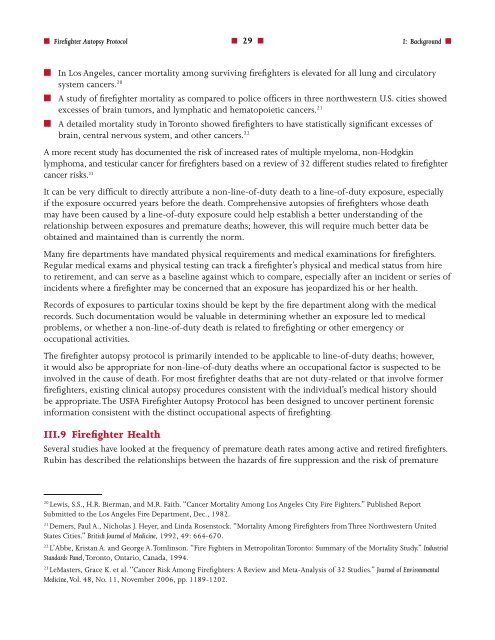Firefighter Autopsy Protocol - US Fire Administration - Federal ...
Firefighter Autopsy Protocol - US Fire Administration - Federal ...
Firefighter Autopsy Protocol - US Fire Administration - Federal ...
You also want an ePaper? Increase the reach of your titles
YUMPU automatically turns print PDFs into web optimized ePapers that Google loves.
■ <strong><strong>Fire</strong>fighter</strong> <strong>Autopsy</strong> <strong>Protocol</strong><br />
■ 29 ■<br />
I: Background ■<br />
■ In Los Angeles, cancer mortality among surviving firefighters is elevated for all lung and circulatory<br />
system cancers. 20<br />
■ A study of firefighter mortality as compared to police officers in three northwestern U.S. cities showed<br />
excesses of brain tumors, and lymphatic and hematopoietic cancers. 21<br />
■ A detailed mortality study in Toronto showed firefighters to have statistically significant excesses of<br />
brain, central nervous system, and other cancers. 22<br />
A more recent study has documented the risk of increased rates of multiple myeloma, non-Hodgkin<br />
lymphoma, and testicular cancer for firefighters based on a review of 32 different studies related to firefighter<br />
cancer risks. 23<br />
It can be very difficult to directly attribute a non-line-of-duty death to a line-of-duty exposure, especially<br />
if the exposure occurred years before the death. Comprehensive autopsies of firefighters whose death<br />
may have been caused by a line-of-duty exposure could help establish a better understanding of the<br />
relationship between exposures and premature deaths; however, this will require much better data be<br />
obtained and maintained than is currently the norm.<br />
Many fire departments have mandated physical requirements and medical examinations for firefighters.<br />
Regular medical exams and physical testing can track a firefighter’s physical and medical status from hire<br />
to retirement, and can serve as a baseline against which to compare, especially after an incident or series of<br />
incidents where a firefighter may be concerned that an exposure has jeopardized his or her health.<br />
Records of exposures to particular toxins should be kept by the fire department along with the medical<br />
records. Such documentation would be valuable in determining whether an exposure led to medical<br />
problems, or whether a non-line-of-duty death is related to firefighting or other emergency or<br />
occupational activities.<br />
The firefighter autopsy protocol is primarily intended to be applicable to line-of-duty deaths; however,<br />
it would also be appropriate for non-line-of-duty deaths where an occupational factor is suspected to be<br />
involved in the cause of death. For most firefighter deaths that are not duty-related or that involve former<br />
firefighters, existing clinical autopsy procedures consistent with the individual’s medical history should<br />
be appropriate. The <strong>US</strong>FA <strong><strong>Fire</strong>fighter</strong> <strong>Autopsy</strong> <strong>Protocol</strong> has been designed to uncover pertinent forensic<br />
information consistent with the distinct occupational aspects of firefighting.<br />
III.9 <strong><strong>Fire</strong>fighter</strong> Health<br />
Several studies have looked at the frequency of premature death rates among active and retired firefighters.<br />
Rubin has described the relationships between the hazards of fire suppression and the risk of premature<br />
20<br />
lewis, S.S., h.R. Bierman, and M.R. faith. “Cancer Mortality Among los Angeles City fire fighters.” Published Report<br />
Submitted to the los Angeles fire Department, Dec., 1982.<br />
21<br />
Demers, Paul A., nicholas J. heyer, and linda Rosenstock. “Mortality Among firefighters from three northwestern united<br />
States Cities.” British Journal of Medicine, 1992, 49: 664-670.<br />
22<br />
l’Abbe, Kristan A. and george A. tomlinson. “fire fighters in Metropolitan toronto: Summary of the Mortality Study.” Industrial<br />
Standards Panel, toronto, Ontario, Canada, 1994.<br />
23<br />
leMasters, grace K. et al. “Cancer Risk Among firefighters: A Review and Meta-Analysis of 32 Studies.” Journal of Environmental<br />
Medicine, vol. 48, no. 11, november 2006, pp. 1189-1202.
















